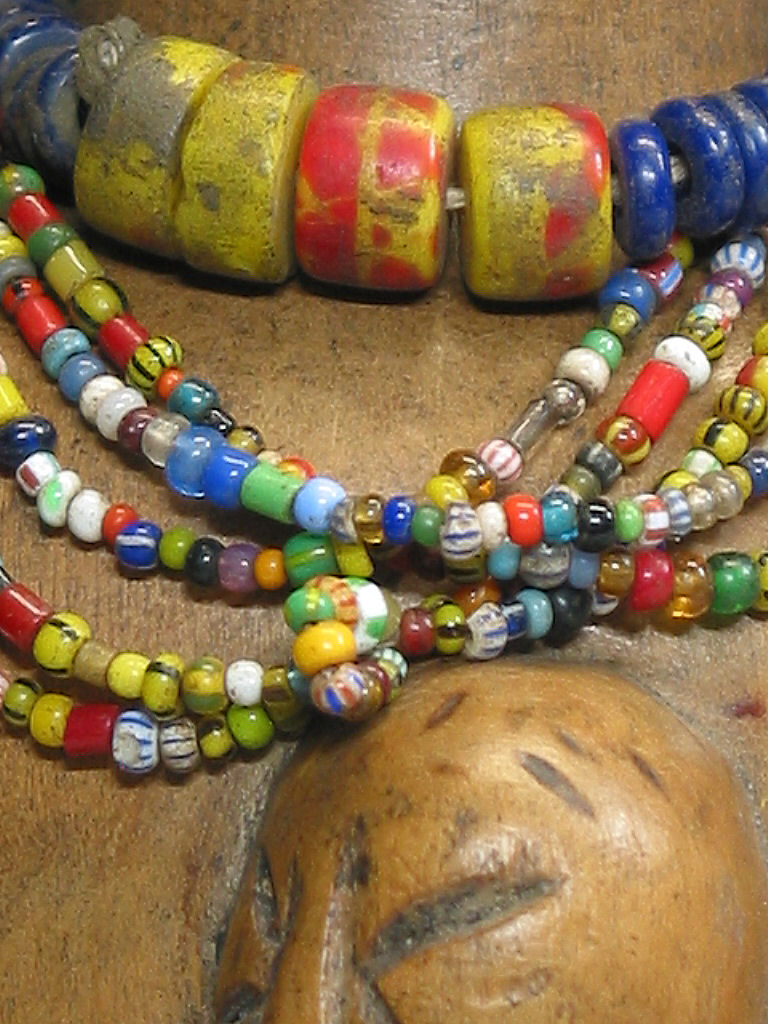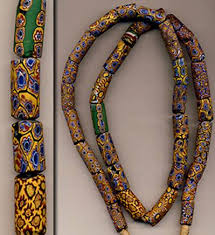 The Ewes have traditionally occupied an area known as the Volta Region. A neat rectangle outlines this geographical area. The rivers Mono and Volta surround this area, extending from the Atlantic coast inland. On the Western boundary is the natural Volta River Estuary, while the Eastern boundary is located along the Ghana-Togo border.
The Ewes have traditionally occupied an area known as the Volta Region. A neat rectangle outlines this geographical area. The rivers Mono and Volta surround this area, extending from the Atlantic coast inland. On the Western boundary is the natural Volta River Estuary, while the Eastern boundary is located along the Ghana-Togo border. The Atlantic Ocean forms the Southern boundary, whereas the Northern boundary reaches up to Atakpame and Kpetsi. Ewe land has a coastline of more than one-hundred miles and extends for more than one-hundred miles into the interior of Ghana.
The Royal beads of the Ewe can signify social value including pride,wealth status and dignity, They can also have different values.
Ewe beads, like those found among other ethnic groups in Ghana, have deep cultural and spiritual significance. The Ewe people, predominantly located in the Volta Region of Ghana, use beads for various purposes, particularly in ceremonies, rites of passage, and as symbols of status and identity.
The use of beads as body adornment has served as a strong non-verbal
communicative device within Ghanaian culture. Decorating oneself with beads can depict a person's mood, project a period in life one is going through, and display the social status of the individual. This study focuses on the significance beads have in portraying the prestige, inheritance and duty of responsibility of traditional figures of authority. The research was concentrated on the chiefs and queen mothers of the Ewe cultural group and
their particular usage of beads as an item of royal regalia.
Behind the beautiful, aesthetic expression of bead adornment is an underlying
principle of reason.
This study investigates answers to why certain beads are only associated with royalty; how "pomp and circumstance" are ever present at formal
ceremonies and the history that encompasses the reasons from where these practices andbeliefs may be derived. Within this work is an outlying historical background of the Ewesof Ghana, including their most recent migration from Togo and the festivals that celebrate this occurrence.
Present at the festivals are notable attire and adornment which reveal the
important positions which royalty hold as both "symbolic figures" and present day "activefigures" in Ewe society. This paper will discuss the special kinds of beads that tell a vital story of the prestige, inheritance, and social status of the chiefs and queen mother. The majority of the information that is found is obtained through oral tradition. It is important for the reader
to have a better understanding of the historical and the geographical background of this particular group.
One must understand this before learning about the importance of the
festivals they celebrate and the reasoning behind the great emphasis on the appearance of certain "dignified" individuals of the Ewe group.
Ornamentation through the use of beads is an integral aspect of Ghanaian culture. Beads often depict a deeper, more meaningful message than the mere aesthetic beauty they often portray. In comparison to the bold, excessive display of gold amongst the Ashanti of Ghana, the royal regalia belonging to the Ewe has remained relatively unnoticed.
This paper focuses on the main item of adornment unique to the Ewe chiefs
and queen mothers of Ghana -- the display of valuable beads. The royal beads of the Ewe can signify social values including pride, wealth, status, and dignity. They can also have different values and attributes based on their source of origin, the status of original possessor, and the means by which they were acquired.
Thus, it is also pertinent to investigate the origins of the so called "royal"beads, including both the informationelicited from former bead researchers and the stories collected from the chiefs, queen mothers, and the older women in the village.
Types and Uses of Ewe Beads
1. Dzotor Beads:
These are waist beads worn by women, traditionally to signify femininity, fertility, and beauty. They are often used to mark significant stages in a woman's life, from puberty to marriage.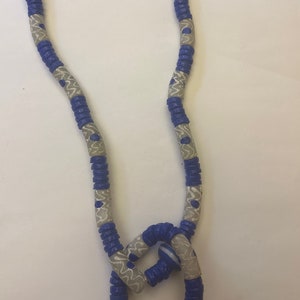

In some cases, the sound of the beads as the wearer moves is believed to enhance sensuality, making them a subtle communication tool in relationships.
Dzotor beads are a traditional type of waist beads worn by Ewe women, primarily from the Volta Region of Ghana. These beads have rich cultural and spiritual significance and are used for various purposes related to femininity, sexuality, and spirituality.
Key Aspects of Dzotor Beads:
1. Symbol of Femininity and Beauty:
Dzotor beads are often seen as symbols of a woman’s beauty and femininity. They are typically worn around the waist, highlighting a woman's figure and enhancing her physical appeal.
These beads are carefully chosen for their colors, patterns, and sizes, with each combination carrying its own meaning.
2. Fertility and Sensuality:
In many Ewe traditions, Dzotor beads are linked to fertility and womanhood. They are sometimes given to young girls during puberty rites to mark their transition into adulthood and their readiness for marriage.
Worn beneath clothing, the beads are also associated with enhancing sensuality, as the gentle sound they make can subtly attract attention from a romantic partner.
3. Health and Body Awareness:
Traditionally, Ewe women wear Dzotor beads to monitor changes in their body, especially their weight. If the beads become tight, it signals weight gain; if they become loose, it indicates weight loss.
Some women also wear the beads during pregnancy to protect the unborn child and ensure a healthy delivery.
4. Spiritual Protection:
Dzotor beads are believed to have protective powers, particularly in warding off negative spiritual influences. In some cases, they are blessed or imbued with spiritual energy by traditional healers or family elders to enhance their protective properties.
5. Color Significance:
The colors of the beads can carry various symbolic meanings:
Red: Symbolizes power, passion, and protection.
Blue: Associated with peace, tranquility, and healing.
Green: Represents fertility, growth, and prosperity.
White: Signifies purity, spirituality, and new beginnings.
6. Cultural Identity and Status:
The wearing of Dzotor beads is a way for Ewe women to express their cultural identity. It is not just a fashion statement but a link to their heritage and traditions.
Among some Ewe communities, certain bead designs or colors are reserved for women of specific social status or roles within traditional ceremonies.
Ceremonial and Everyday Use:
While Dzotor beads are often worn for everyday purposes such as body adornment and health awareness, they are also used in important ceremonies, such as: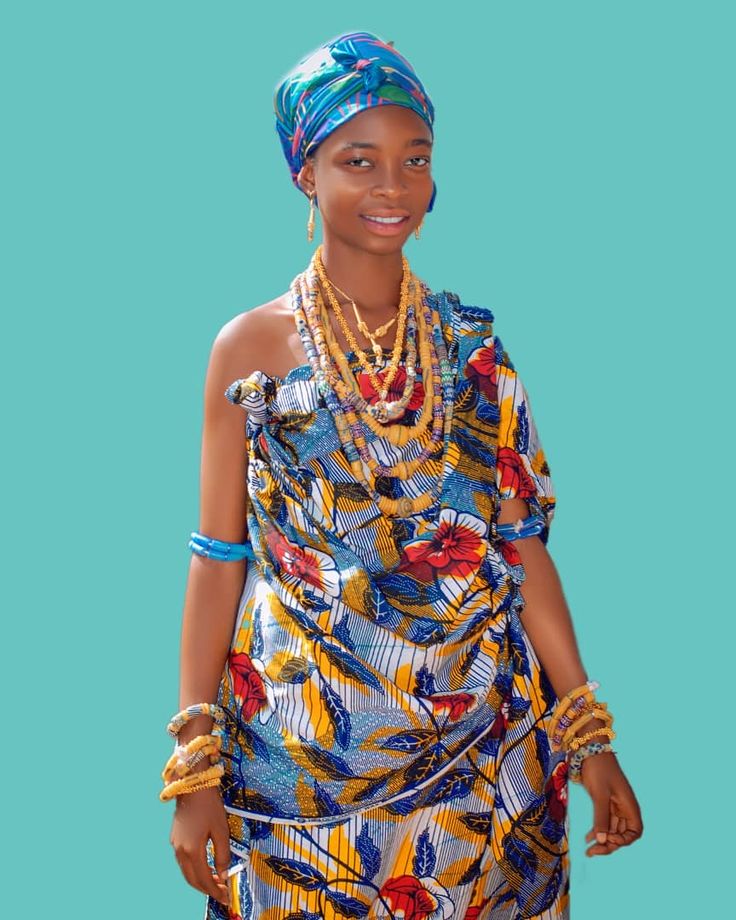

Puberty rites: Girls wear these beads during rites of passage into womanhood.
Marriage ceremonies: Women adorn themselves with beads as part of their bridal attire, symbolizing their fertility and readiness for marriage.
Festivals and Rituals: Dzotor beads are also worn during traditional Ewe festivals and religious rituals, where they take on more spiritual significance.
In summary, Dzotor beads are more than just decorative items; they hold deep cultural, spiritual, and social importance in Ewe communities, symbolizing beauty, womanhood, and spiritual protection.
2. Agave Beads:
Typically used in religious and ceremonial contexts, Agave beads are strung together and worn during important rituals. They might also be used to create talismans or amulets to protect the wearer from spiritual harm.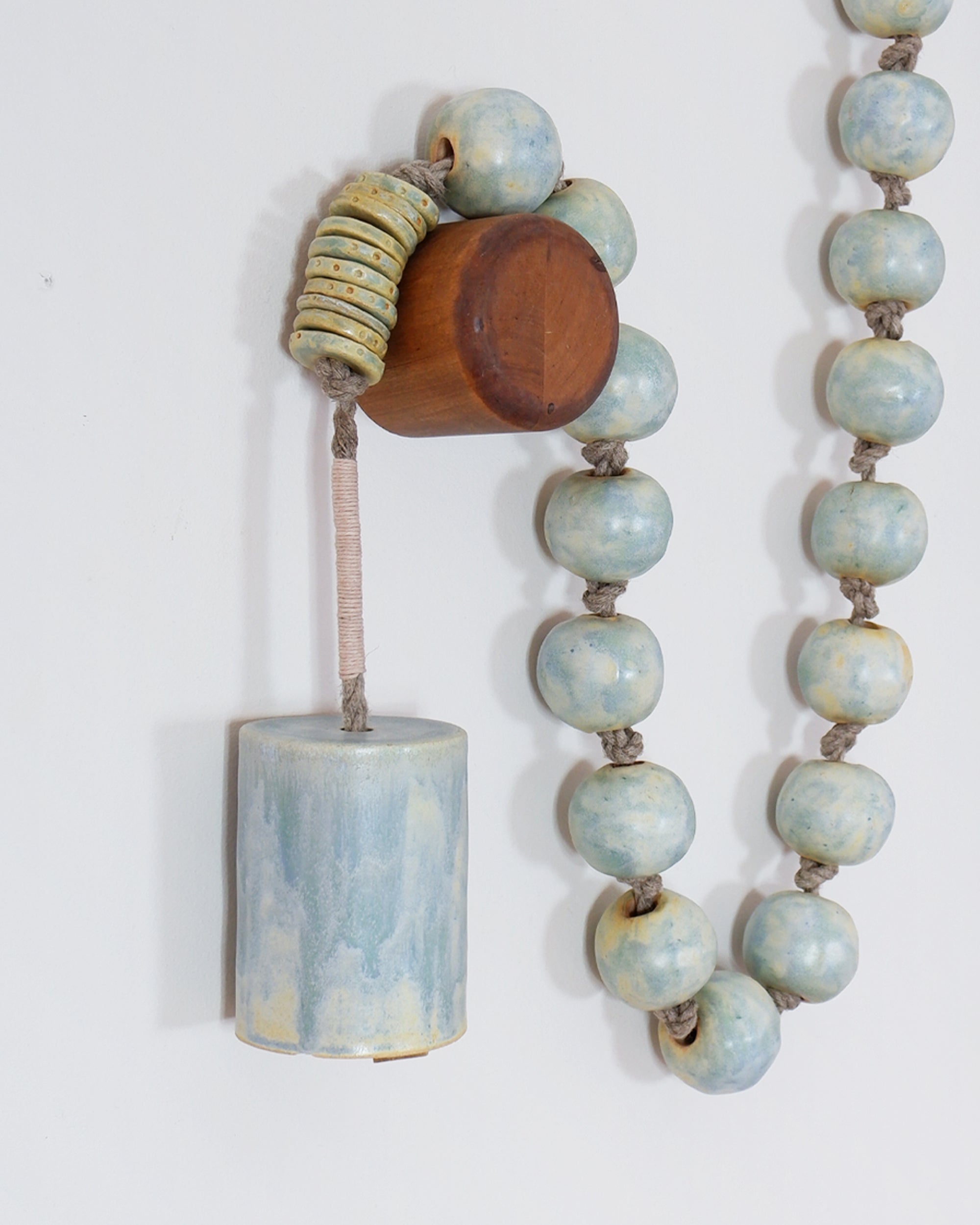

Agave beads are a type of traditional beads used by the Ewe people, particularly in spiritual and ceremonial contexts. They hold both cultural and religious significance, often used during important rituals and in daily life. While not as widely known as some other bead types, Agave beads are integral to the cultural practices of the Ewe people.
Key Aspects of Agave Beads:
1. Religious and Ceremonial Use:
Agave beads are frequently used in religious ceremonies and spiritual rituals among the Ewe. They play a significant role in rites that involve communication with ancestors and deities, with the beads sometimes used as offerings or as part of the ritual adornment of participants.
In some ceremonies, the beads may be strung together and worn to signify the wearer's connection to spiritual powers or their role within the ritual.
2. Spiritual Significance:
The spiritual power of Agave beads lies in their ability to serve as conduits between the physical and spiritual realms. They are often blessed by spiritual leaders or priests, allowing them to act as protective talismans, providing spiritual protection or invoking blessings from ancestors.
Beads may be used in specific patterns or colors to reflect certain deities or spiritual intentions, with the belief that different combinations of beads can summon different energies or powers.
3. Protection and Healing:
Just like other traditional beads, Agave beads are believed to offer protection from evil spirits, negative energies, or harm. Some Ewe people wear these beads for personal protection, or they may be placed around homes or shrines to ward off misfortune.
In addition, they are sometimes used in healing rituals, where the beads are believed to channel healing energies or help individuals recover from physical or spiritual ailments.
4. Status and Authority:
Agave beads are often worn by individuals of high status within the community, such as chiefs, elders, or spiritual leaders. The beads can symbolize power, authority, and connection to the ancestral world, distinguishing the wearer as a person of influence.
The type and arrangement of Agave beads worn may indicate the specific rank or role of the individual during ceremonies, particularly in leadership or spiritual positions.
5. Colors and Symbolism:
The colors of Agave beads can carry specific meanings, much like other beads in African traditions. Common color associations include:
Red: Power, protection, and spiritual energy.
Black: Wisdom, maturity, and connection to ancestors.
White: Purity, peace, and divine intervention.
Green: Fertility, growth, and prosperity.
Yellow/Gold: Wealth, royalty, and abundance.
6. Cultural Expression:
Agave beads are not only spiritual tools but also part of the broader cultural expression of the Ewe people. They are often worn during festivals, traditional dance performances, and other communal events as a way to celebrate and preserve Ewe heritage.
The aesthetic appeal of these beads, combined with their spiritual significance, makes them an important symbol of identity for the Ewe people.
Ceremonial and Spiritual Roles:
Ritual Beads: Agave beads are a common element in religious and spiritual practices, used in offerings to gods or ancestors and to enhance the spiritual potency of rituals.
Ancestral Worship: In ceremonies that honor the ancestors, Agave beads may be worn by participants or placed on altars as a way of inviting ancestral spirits to offer blessings and protection.
Divination: In certain cases, beads like Agave beads may be used in divination practices to seek guidance from the spiritual realm, with spiritual leaders interpreting their arrangement to provide insights or answers to questions.
Conclusion:
Agave beads are deeply embedded in the spiritual and cultural life of the Ewe people, acting as symbols of protection, power, and spiritual connection. Whether worn in everyday life or used during sacred rituals, they represent an important link between the physical and spiritual worlds, carrying centuries of tradition and meaning.
3. Krobo Beads (used by Ewes):
Although these beads originate from the Krobo people, they are widely used among the Ewe as well. Made from recycled glass, they are often worn during festivals, initiation ceremonies, and important life events like marriages.
Krobo beads are a significant cultural element, primarily associated with the Krobo people of Ghana, but they are also widely used by the Ewe people, especially in the Volta Region. These beads are made from recycled glass and are known for their vibrant colors and intricate designs. They carry deep cultural, spiritual, and social meanings.
Key Aspects of Krobo Beads Used by Ewes:
1. Cultural Significance:
Krobo beads are often worn by Ewe women during various ceremonies, festivals, and traditional events. They symbolize beauty and femininity and are used to enhance traditional attire.
The beads are often considered family heirlooms, passed down through generations, and are associated with heritage and cultural identity.
2. Rites of Passage:
Similar to their use among the Krobo people, Ewe communities incorporate Krobo beads into important life events such as puberty rites, marriages, and funerals. They mark significant transitions in life and are often gifted during these ceremonies.
For young girls undergoing initiation ceremonies, wearing Krobo beads signifies their transition into womanhood and the responsibilities that come with it.
3. Symbol of Fertility and Protection:
Krobo beads are often associated with fertility and motherhood. Pregnant women may wear them as a protective measure for both themselves and their unborn children.
The beads are sometimes blessed or specially crafted to enhance their protective qualities, helping to ward off negative energies and evil spirits.
4. Spiritual and Ritual Use:
In Ewe spiritual practices, Krobo beads are used in rituals to connect with ancestors and deities. They may be incorporated into altars or worn during ceremonies to invoke blessings and protection.
The beads can also be used as offerings to deities or spirits, demonstrating reverence and seeking favor.
5. Color and Design Significance:
Krobo beads come in various colors, each carrying its own meaning. Common colors include:
Blue: Peace and tranquility.
Red: Power and protection.
Green: Fertility and growth.
White: Purity and spirituality.
The arrangement and combination of colors can also convey specific messages or intentions in spiritual and cultural contexts.
6. Social Status and Identity:
Wearing Krobo beads can signify social status within the Ewe community. Certain bead designs or combinations may be reserved for individuals of higher social standing or specific roles within the community, such as chiefs or elders.
The choice of beads can reflect personal identity, expressing the wearer’s connection to their culture and heritage.
7. Artisan Craftsmanship:
The production of Krobo beads involves a meticulous process of recycling glass, which is then shaped and decorated. This craftsmanship is an art form passed down through generations, often involving community collaboration.
The vibrant colors and unique designs reflect the creativity and skill of the artisans, making each piece distinctive.
Krobo beads hold significant cultural and spiritual importance among the Ewe people. They serve as symbols of beauty, protection, and cultural identity while playing vital roles in ceremonies and rites of passage. Through their vibrant colors and intricate designs, Krobo beads reflect the rich heritage and traditions of the Ewe and Krobo peoples in Ghana.
4. Fertility Beads:
Like other African cultures, the Ewe people use beads, particularly waist beads, to enhance fertility or promote a healthy pregnancy. These beads are sometimes blessed by elders or traditional healers to give them additional spiritual potency.
Fertility beads among the Ewe people, as well as in other West African cultures, carry deep significance related to fertility, femininity, and womanhood. These beads are often used in various cultural practices, ceremonies, and personal adornment to symbolize and enhance fertility, reproductive health, and the connection to motherhood. Here’s an overview of the significance and uses of fertility beads within the Ewe culture:
Significance of Fertility Beads for the Ewe
1. Symbol of Femininity:
Fertility beads are primarily worn by women to celebrate and enhance their femininity. They often signify a woman’s readiness for marriage and motherhood, embodying the beauty and strength associated with womanhood.
2. Cultural Practices and Rites of Passage:
In Ewe culture, fertility beads play a crucial role in rites of passage, especially during puberty ceremonies. Young girls may receive these beads as a symbol of their transition into womanhood, marking their readiness to bear children.
During marriage ceremonies, brides often wear fertility beads to symbolize their fertility and the hopes for a fruitful union.
3. Protection and Blessing:
Fertility beads are sometimes blessed by spiritual leaders or elders to enhance their protective properties. Women may wear them during pregnancy to protect both themselves and their unborn children from negative energies or evil spirits.
The beads are believed to attract positive energies and promote a healthy pregnancy, ensuring the well-being of both mother and child.
4. Health Awareness:
In addition to their symbolic significance, fertility beads can also serve as a practical tool for women to monitor their reproductive health. The fit of the beads can indicate weight changes, and their presence can encourage awareness of bodily health.
5. Spiritual Connection:
Fertility beads are often used in spiritual rituals, where they can act as a medium to connect with ancestors or deities related to fertility and motherhood. They may be offered in prayers or placed on altars to invoke blessings for fertility.
6. Artisan Craftsmanship:
These beads are often handmade by artisans using various materials, including glass, clay, and seeds. The craftsmanship can involve intricate designs, colors, and patterns that are culturally significant, with each bead representing different aspects of fertility and femininity.
7. Communal Identity and Tradition:
Wearing fertility beads is a way for Ewe women to express their cultural identity and connection to their community. These beads are often seen as a part of traditional attire, especially during festivals and communal gatherings, emphasizing the cultural heritage of the Ewe people.
Colors and Meanings
The colors of fertility beads can carry specific meanings:
Red: Often associated with passion, love, and protection.
Green: Symbolizes fertility, growth, and prosperity.
White: Represents purity, spirituality, and new beginnings.
Yellow/Gold: Linked to wealth, abundance, and fertility.
Fertility beads are an essential part of Ewe culture, serving as symbols of femininity, protection, and connection to community and spirituality. They play vital roles in ceremonies and personal expression, reflecting the deep cultural values surrounding womanhood, motherhood, and fertility in Ewe society.
5. Ritual Beads:
The Ewe often use bea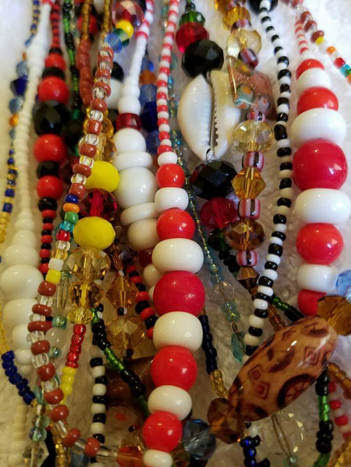 ds in spiritual rituals. During ceremonies to honor ancestors or deities, beads are offered as gifts or worn to invoke blessings and protection from spiritual entities.
ds in spiritual rituals. During ceremonies to honor ancestors or deities, beads are offered as gifts or worn to invoke blessings and protection from spiritual entities.
 ds in spiritual rituals. During ceremonies to honor ancestors or deities, beads are offered as gifts or worn to invoke blessings and protection from spiritual entities.
ds in spiritual rituals. During ceremonies to honor ancestors or deities, beads are offered as gifts or worn to invoke blessings and protection from spiritual entities.Ritual beads hold significant cultural and spiritual importance among the Ewe people of Ghana. They are integral to various ceremonies, rituals, and spiritual practices, serving as tools for communication with the spiritual realm, protection, and expression of cultural identity. Here’s an overview of the significance and uses of ritual beads among the Ewe:
Key Aspects of Ritual Beads for the Ewe
1. Spiritual Connection:
Ritual beads are often used to connect with ancestors, deities, and spiritual forces. They are seen as conduits that facilitate communication and invoke blessings, guidance, and protection during ceremonies.
Beads may be worn or offered during rituals, with specific arrangements or colors symbolizing different spiritual intentions.
2. Ceremonial Use:
In various ceremonies, such as weddings, initiations, and festivals, ritual beads are worn by participants to enhance the spiritual significance of the event. They signify the wearer's role within the ceremony, often representing connection to the community and cultural heritage.
During funerals and memorials, ritual beads may be used to honor the deceased, offering them as gifts or adorning altars as a means of inviting ancestral spirits to bless the gathering.
3. Protection and Empowerment:
Many Ewe believe that ritual beads possess protective properties. They are often blessed by spiritual leaders, imbuing them with the ability to ward off negative energies, evil spirits, or misfortune.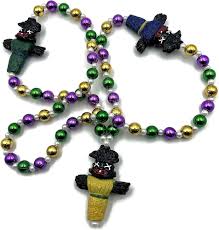

Wearing these beads during important life events is believed to provide spiritual strength and guidance, ensuring the individual is safeguarded during the ritual.
4. Rites of Passage:
Ritual beads are crucial during rites of passage, such as puberty initiations for girls and young men. They symbolize the transition from childhood to adulthood, marking the individual’s new responsibilities within the community.
During these ceremonies, beads may be given as gifts to signify the importance of the transition and to welcome the individual into the next phase of life.
5. Artisan Craftsmanship:
Ritual beads are often handcrafted using various materials, including glass, clay, seeds, and even metal. The craftsmanship involved reflects cultural traditions and artistic expressions unique to the Ewe people.
The intricate designs and colors of the beads can carry specific meanings, with artisans often incorporating cultural symbols and motifs into their creations
6. Cultural Identity:
Wearing ritual beads is a way for Ewe individuals to express their cultural identity and heritage. The beads serve as a visible reminder of their traditions and connections to their ancestors.
In communal settings, such as festivals and gatherings, ritual beads are worn collectively, reinforcing a sense of belonging and shared identity among community members.
Types of Ritual Beads
While there are various types of beads used in Ewe rituals, some commonly used ones include:
Agave Beads: Used in spiritual and religious ceremonies, often to invoke blessings and protection.
Krobo Beads: Colorful glass beads that are widely used in rituals and celebrations, signifying cultural identity and heritage.
Fertility Beads: Although primarily associated with femininity and motherhood, these beads can also be incorporated into rituals that celebrate fertility and life.
Ritual beads are vital components of Ewe cultural and spiritual practices. They serve not only as decorative items but as powerful tools for communication, protection, and cultural expression. Through their use in ceremonies and rituals, Ewe beads reinforce community ties, honor ancestral connections, and embody the rich traditions of the Ewe people.
Spiritual and Cultural Significance of Ewe Beads
1. Status and Identity:
Among the Ewe, beads are used to signify one's social standing or role within the community. Chiefs and other important figures may wear large, intricate beads to symbolize power, authority, and connection to the ancestral world.
2. Protection:
Certain beads are believed to offer spiritual protection. When worn, they can act as amulets to safeguard the individual from evil spirits or misfortune. Special beads are sometimes crafted and consecrated for this purpose.
3. Rites of Passage:
Beads play an essential role in Ewe puberty rites for girls, known as Dipo (though this is more common among Krobo, it influences Ewe customs). Young girls wear beads to symbolize their transition into adulthood, with the beads often becoming a family heirloom passed down through generations.
4. Communication with Spirits:
In Ewe spiritual practices, beads are used in rituals to connect with ancestors or deities. They are often worn during divination or placed on shrines as offerings to appease spiritual beings and ensure protection and blessings.
Ewe beads thus carry immense meaning, being intertwined with the wearer’s identity, spiritual well-being, and social status.


